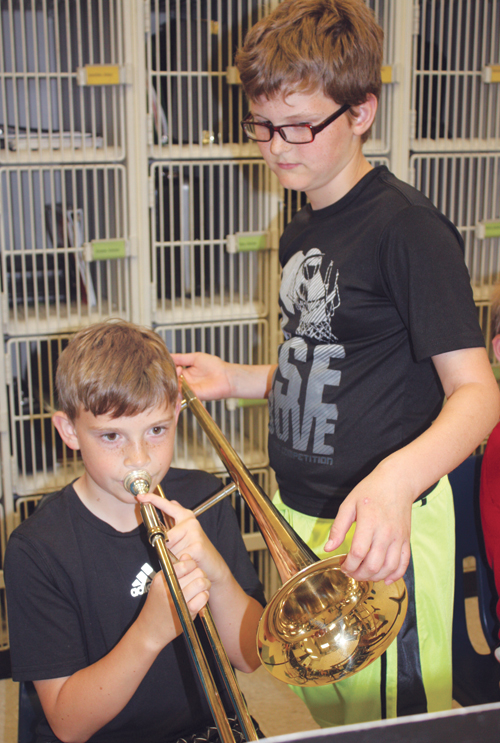
We recently visited a school noted for consistent superior ratings each year and the highest percentage of All-State students in their state. The students were in groups of two to four and spread out all over the band room. Everyone was practicing at the same time. This might be a nightmare to some teachers, but because the directors made a point of developing strong student leaders, students were doing excellent work.
A strong leadership system imparts knowledge at a high level, encourages rigorous teaching and learning with respect and discipline, and rewards eager young players while inspiring the weaker students. This system should develop teamwork, teach the strong performers to assist others, and build everyone up to their highest potential. Leadership in this system will look different for students and teachers. For students, leadership is the ability to genuinely care for members in their section and to help everyone do well and save time for the director. For directors, leadership is the management of student ensembles into performing beyond their learned capacity. This takes the development and modeling of a selfless approach to learning.
Hopefully, in a typical setting, the leadership skills that are developed every day through demonstrated knowledge, thoughtful interactions, clear expectations, and honest evaluations will eventually carry over into the students’ relationships with others in your band program. These leadership skills will affect every single student in your band program and feed over into the next generation.
Instrument Night
Leadership begins with trust. The students should trust your ability to help them succeed and protect them from failures, humiliation, and self-defeating attitudes. The director’s responsibility is to estimate the potential success of each student on an instrument and help students decide on an instrument that suits them best (even if it might not be that student’s first choice), bearing in mind the instrumentation needs of your ensemble and the ensembles that your program feeds. To pass this knowledge along, directors have to teach the fundamentals of tone production on any instrument to a potential student efficiently; teachers earn trust from beginning students by having the knowledge needed for a good start.
At instrument night, appoint new students who show great potential on an instrument to assist you and others with that instrument. Ask students to do anything that you trust them with; this makes students feel important in the band room, and they will view it as a good place to be. This is the time when directors will have substantial influence over parents and other students in selecting an instrument; show immediate respect by referring to all parents and students as “sir” or “ma’am.”
As students try instruments, require correct playing at all times. Immediately begin teaching students to diagnose, evaluate, and fix instrumental problems. There is no reason this cannot begin even on the first night. Good questions to ask include “Which students are matching this pitch on a mouthpiece?” or “Can you hear highs and lows?”
The First Week of Band
The director leads this time by implementing and establishing a routine to develop skills with daily work on basic musicianship. This includes sitting on edge of chair, keeping feet flat on floor, tapping toes, and looking to the podium for instruction. Encourage enjoyment of performing. Praise students frequently for effort and results. Allow for mistakes. A mistake is okay, but poor effort is not. Always insist that the instrument be played correctly even when a note or rhythm is incorrect. Remind the students of all the fundamentals. Create a concise checklist for the students to follow each time the instrument is placed to the face. Outside of rehearsals, keep teachers and parents informed of progress and inform parents and students of private lesson opportunities.
Before Rehearsal Begins
While students prepare for rehearsal, directors should observe them, making note of musical problems that arise as students practice, as well as any physical or emotional changes. Section leaders should learn the strengths and weaknesses of their sections and hold each other accountable. All students should be encouraged to assist each other in developing skills and preparing for rehearsal.
Create a businesslike atmosphere and a culture that respects making good music by making sure each student has a job to do once they enter the classroom. We give students five to seven minutes before stepping on the podium. This is primarily the time for students to explore their instruments, including checking the condition and response of their instrument (and reeds) by playing part or all of the chromatic scale. Students can also tune and should be preparing their music and working with each other on it. Percussionists should make sure all the instruments are ready to go. Everything that happens during this time should have a purpose.
Warmups
After the alloted time is up, warmups begin. The room should be silent the instant your foot hits the podium, and no other prompt should be necessary for students to be silent and still. Another important rule to establish is that all eyes are on you when you lift the baton. Warmup time determines the success or downfall of a program, because this is when the band’s sound is established and the rehearsal procedures and the expectations are set. Directors and students should both know how the band is supposed to sound.
We start warmups by requesting a tuning note from a student. Once this student is in tune, prep the band to match the pitch. Have the band hold the pitch for one to three minutes with no fluctuations or deviations in pitch, insisting that students exit, breathe, and come back in without notice.
After this, we proceed through exercises and scales, holding students to the established expectations. This can include breathing together, starting and stopping together, matching pitch, and placing all of the tuning mechanisms in their correct places to match the ensemble daily. Warmups are also the time to teach and review the skills to be applied to the literature later in the rehearsal.
Although warmups are primarily a time for the director to lead, section leaders can walk around their section to monitor and fix problems. First chair players of second and third parts should also be leaders who check to see that everything is operating correctly in the section.
Rehearsal
This is where the joy of making music comes into play. If the warmup is productive, then students will like their sound and enjoy making music. A good warmup that is applicable to the rehearsal agenda and pieces to be played can save substantial rehearsal time. When the concepts covered in warmups appear in the literature, students should recognize them and be able to play them correctly.
Rehearsals are time to build trust with students. The director should make eye contact with each player, evaluating them visually and aurally. Every student should be your favorite. Never humiliate a student. Find ways to single out and fix problems without making a struggling player wish he was somewhere else.
Teachers should have an unwavering commitment to helping students achieve their highest potential. Avoid short-selling beginners because they are young or withholding information that will help them improve.
Conclusion
Band is a business built of hard-working students. Give all students a responsibility. Leadership comes in many forms, and students who are made to feel important are students who care. Designate who is first chair in each section, but also make note of students who have particular musical strengths; these players can be put in charge of tempo if they have excellent pulse or in charge of pitch if they consistently play in tune. To incorporate the strengths of all students, leaders may also be appointed to library, supplies, or rehearsal logistics staff.
Success follows band directors who respect and trust each other, and this mutual feeling carries over into students’ interactions with each other. In just a couple years, students’ improved practice skills, shared musical expectations, and better discipline and behavioral habits will lead to a more positive band room atmosphere and easier and more enjoyable teaching and learning experiences.





